बासमती चावल के 10 प्रमुख रोग और उनका प्रबंधन
Rice (Oryza sativa) is one of the most important food crops. It is staple food for more than half of the world’s population. India is one of the largest rice growing country with an area of around 44 m ha and production of more than 100 million tonnes.
Rice is grown in almost all the states of India contributing about 42 per cent to the country’s food grain production and provides livelihood to about 70 per cent of the population.
Basmati Rice, a special class of rice has contributed significantly for rice production and its export to other countries and is in high demand due to its high cooking quality and special aroma. During 2011–12 a total of 3.21 million tonnes of basmati rice was exported from India. But the bottleneck in its production is the disease pests.
Unlikely to general rice, Basmati group is more prone to Bakanae disease along with some other important diseases. Recently there have been reports from USA and European countries regarding residue of fungicides in basmati rice which is detrimental for human health. The residue can be minimized by application of fungicides at recommended dosages and at appropriate time/stage.
In the present article major diseases of basmati rice noticed in north western plain zone of India are discussed with their proper management techniques.
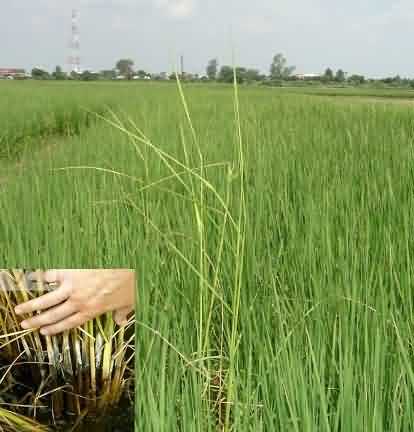 1. Foot rot or Bakanae Disease or foolish seedling disease:
1. Foot rot or Bakanae Disease or foolish seedling disease:
Pathogen: This disease is caused bya fungus Fusarium moniliforme which is a synonym of Fusarium fujikuroi. Its perfect stage is Gibberella fujikuroi.
Symptoms: This disease is both seed and soil borne. The infected plants are several inches taller than normal plants in the seedbed and field. Diseased seedlings remain thin with yellowish green leaves and pale green flag leaves. The affected seedlings die at early tillering. In late infections, tillering is reduced and the leaves dry up. In surviving plants, partially filled, sterile or empty grains can be seen at maturity. Infected seedlings show lesions on roots which turn brown. These infected seedlings may die before or after transplanting.
Management:
- Disease free seeds should be used to minimize the occurrence of the disease.
- Salt water can be used to separate lightweight, infected seeds from seed lots and thereby reduce seed-borne inoculum followed by washing the seed 2-3 times in fresh water.
- Seedlings in nursery should be uprooted under water to avoid injury to roots.
- Early draining of the fields should be avoided because the aerobic fungus may reproduce rapidly in the presence of oxygen.
- Avoid high application of nitrogenous fertilizers as it favours the development of the disease.
- Seed treatment using fungicides such as Thiram or carbendazim @ 2.5g/kg seed or thiophanate-methyl–70 W.P. is effective before sowing.
- Foliar spray with carbendazim @ 2.5g/ litre gives good control of this disease in the field.
- 2.5 kg of Trichoderma viride is mixed well in 60 kg of FYM and after 5–7 days this mixture should be applied in one ha area. This practice helps to reduce the post transplanting infection of the disease.
- Rouge out infected tall plants from the field carefully along with the roots.
2. Brown Spot Disease:
Pathogen: This disease is caused by Helminthosporium oryzae (Syn. Bipolaris oryzae, Drechslera oryzae). Its perfect stage is Cochliobolus miyabeanus.
Symptoms: The disease appears from seedling to milking stage. The symptoms appear as minute circular or oval, brown lesions or dots on the coleoptiles, leaf blade, leaf sheath and glumes, being most prominent on the leaf blade and glumes. These lesions may girdle the coleoptiles and cause distortion of the primary and secondary leaves leading to seedling blight. The spots have a light brown to gray centre, surrounded by a reddish brown margin. Several spots coalesce and the leaf dries up. Infected seedlings become stunted or die. Affected nurseries can be often recognized from a distance by their brownish scorched appearance. Velvety appearance of lesions is visible on infected glumes under severe conditions. Infected grains show black discoloration or brown lesions.
Management:
- Since the fungus is seed transmitted, a hot water seed treatment (53–54°C) for 10-12 minutes may be effective before sowing. Pre-soaking the seed in cold water for 8 hours increases effectivity of this treatment.
- Seed treatment with captan, thiram or carbendazim @ 2.5 g/kg seed has been found to reduce seedling infection.
- Application of nitrogen in three split dosages and correction of soil deficiency with potash, manganese and zinc.
- Removal of collateral hosts and infected debris on the bunds and in the main field.
- Seed treatment with carbendazim @ 2.0 g/kg seed is effective against the disease.
- Spray the crop with Dithane Z–78 or mancozeb 75% WP (Dithane M–45) @ 2.5 g/l at 10–12 days interval just after the appearance of the initial symptoms. Application of edifenphos (hinosan), iprodione or carbendazim in the field as foliar spray is also advisable.

Pathogen: This disease is caused by a fungus Rhizoctonia solani and its perfect stage is Thanatephorus cucumeris.
Symptoms: The disease symptoms start with small, ellipsoidal or ovoid, greenish-grey and water-soaked lesions which usually develop on leaf sheaths near the water line in lowland fields. Older lesions are elliptical or ovoid with a greyish white centre and light brown to dark brown margin. Under favourable conditions, lesions on the upper parts of the plant extend rapidly to cover entire tillers up to the flag leaf. These lesions may coalesce forming bigger lesions with irregular outline and may cause death of the whole leaf and in the severe cases all the leaves of the plant become blighted. The infection spreads to the inner sheath and resulting in death of the entire plant. Older plants are highly susceptible. Severely infected plants produce poorly filled or empty grains, especially those on the lower portion of the panicles. The fungus affects the crop from tillering to heading stage.
Management:
- High seeding rate or dense plant spacing should be discouraged to avoid dense crop growth which favours horizontal spread of the disease.
- Need-based or balanced application of nitrogen fertilizers in the fields help to minimize the disease incidence, as high application of nitrogen aggravates this disease.
- Sanitation, specifically removing of weeds, can help to control sheath blight because the pathogen also attacks weeds which are commonly found in rice fields. Removal of infected stubbles or crop residues from the field is also recommended to reduce the amount of inoculum for the succeeding cropping season.
- In the affected crop, irrigation should be restricted as humidity favours the disease development.
- Spraying the crop with hexaconazole 5% SC @1.0–1.25 litre/ha or carbendazim @1.0–1.2 kg/ ha or propiconazole @ 500 ml/ ha or validamycin 3L @ 1.0–1.2 litre/ ha in 500 litres of water give effective results against this disease.
- Many combination products like Nativo 75 WG (trifloxystrobin and tebuconazole combination) @ 0.4 g/l, Filia 52.5 SE (tricyclazole and propiconazole) and Lusture 37.5 SE (flusilazole in combination with carbendazim) have also been found very effective against the disease.
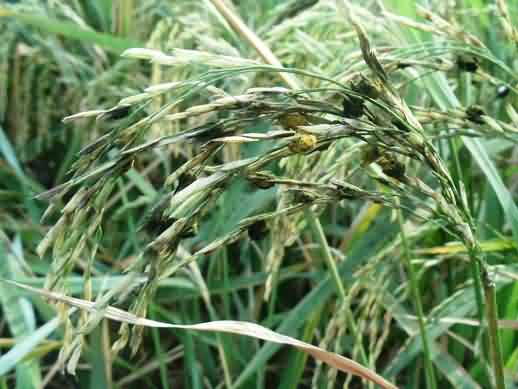
Pathogen: This is a fungal disease, caused by Ustilaginoidea virens. The perfect stage of this pathogen is Claviceps oryzae-sativae.
Symptoms: False smut is one of the emerging fungal grain diseases of rice, wherein the individual rice grains get transformed into a mass of velvety spores. The symptoms are visible after flowering only, where the fungus infects the young ovary of individual kernel and transform them into large, velvety green balls (smut balls). Initially the smut balls are small and remain confined between glumes. They gradually enlarge and enclose the floral parts. The smut balls are initially yellow in colour and are covered by membrane which later bursts and the colour changes to orange, yellowish green, green, olive green and finally greenish black. Only few grains in a panicle are usually infected and the rest are normal.
Management:
- Use disease free seeds from disease free area.
- Early planting can help to escape heavy disease incidence.
- Destruction of diseased grains and stubble from infected plants is recommended to reduce the disease.
- At tillering and pre-flowering booting stages, spraying of carbendazim or copper oxychloride (Fytolan or Blitox–50) fungicide @ 2.5–3.0g/litre of water can effectively reduce the disease incidence.
- Spraying of propiconazole 500ml/ha or hexaconazole 1000 ml/ ha before seed formation is also helpful in reducing disease incidence.
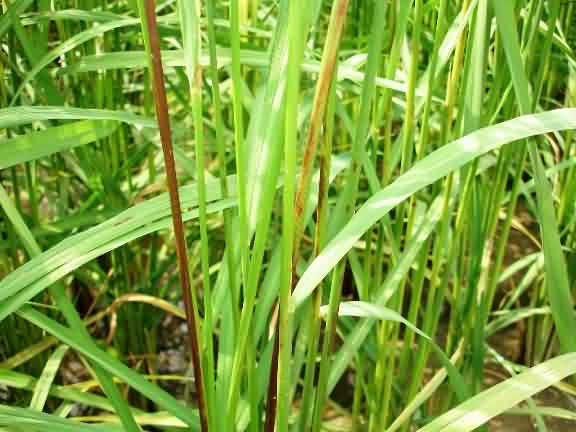
Pathogen: This is a fungal disease, caused by Sarocladium oryzae.
Symptoms: The infection occurs on the uppermost leaf sheath enclosing the young panicles at late booting stage. The initial symptoms of this disease are oblong or somewhat irregular brown spots or lesions, 0.5-1.5 cm long, with dark reddish brown margins and gray centre. Lesions may also consist of diffuse reddish brown discoloration on the sheath. Lesions enlarge and often coalesce and may cover the entire leaf sheath. Severe infection causes entire or parts of young panicles to remain within the sheath. Un-emerged panicles rot and florets turn red-brown to dark brown and visible abundant whitish powdery growth is observed inside these affected sheaths and young panicles. Infected panicles are discoloured, sterile, shrivelled or with partially filled grain, if the pathogen attacks after the panicle emergence.
Management:
- Removal of infected plant and optimum plant spacing are among the cultural practices that help to reduce the disease.
- Application of potash at tillering stage is also recommended.
- Seed treatment with mancozeb 75 WP @ 2.5 g/kg of seed or captan 50 WP @ 2.0 g/kg of seed.
- Foliar spray of calcium sulphate and zinc sulphate helps in control sheath rot.
- Foliar spraying at booting stage, with carbendazim or benomyl or copper oxychloride or edifenphos or mancozeb was found to reduce sheath rot. Spray of 0.1% tilt 25 EC (propiconazole) or octave (prochloraz) gives effective control of sheath rot.
6. Stem Rot Disease of Basmati:
Pathogen: This disease is caused by a fungus Sclerotium oryzae. Its perfect stage is Magnaporthe salvinii.
Symptoms: Initial symptoms of the disease are small, irregular black lesions on the outer leaf sheath near water level. These lesions expand as the disease advances and severely infected stems rot. Numerous tiny white and black sclerotia and mycelium inside the infected culms are visible. Infected culm collapses and plant lodges. If the diseased tiller is opened, profuse mycelial growth and large number of sclerotia can be seen. The sclerotia may be seen in the stubbles after crop harvest. The disease causes unfilled panicles and chalky grain. Severe infection causes death of tillers. The disease aggravates lodging of plants.
Management:
- Burning straw and stubble or any crop residue after harvest or allowing the straw to decompose and draining the field can reduce sclerotia in the field.
- Balanced use of fertilizers or split application with high potash and lime to increase soil pH reduces stem rot infection.
- Deep ploughing in summer is helpful to reduce the inoculum level for next crop season.
- Avoid standing water in the field for a long period and improve drainage facility in the fields where disease occurs in endemic form. Avoid flow of irrigation water from infected fields to healthy fields.
- Spray fungicides like mancozeb or carbendazim @ 1.5–2.5g/litre. Chemicals such as fentin hydroxide sprayed at the mid-tillering stage, thiophanate-methyl sprayed at the time of disease initiation can reduce stem rot incidence in the rice field. The use of validamycin–A is also effective against the fungus.
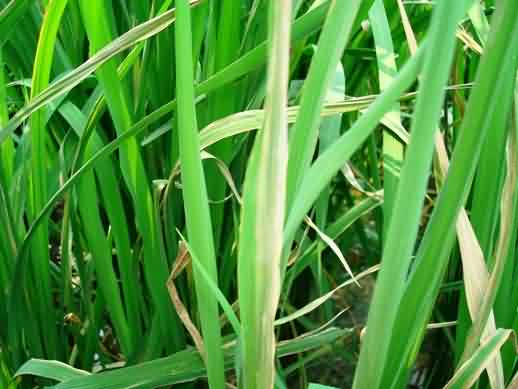
Pathogen: This is a bacterial disease, caused by a bacterium Xanthomonas oryzae pv. oryzae.
Symptoms: The symptoms of this disease occur in two phases viz., leaf blight phase and seedling blight or ‘kresek’ phase.
Leaf Blight Phase: The disease starts with the formation of water-soaked lesions on the tip of the leaves which increase in length and width downwards and turn yellowish to straw colour stripes with a wavy margin. These lesions may develop at one or both edges of the leaves or along the mid rib. There is an appearance of bacterial ooze that looks like milky or opaque dewdrop on young lesions early in the morning. Lesions turn yellow to white as the disease progresses. Severely infected leaves tend to dry quickly. Lesions later become greyish from growth of various saprophytic fungi.
Seedling Wilt or Kresek Phase: Kresek phase is observed 1-3 weeks after transplanting. Green water-soaked layer along the cut portion or leaf tip of leaves are early symptoms. Leaves wilt and roll up and become greyish green to yellow. Entire plant wilts completely. Infected leaves of mature plant turn yellow to pale yellow. Youngest leaf is uniform pale yellow or has broad yellow stripe. Panicles remain sterile and unfilled but not stunted under severe conditions.
The kresek infected tillers may be confused with the stem borer injury but the latter can be easily pulled out while it is not so with the kresekinfected tillers.
Management:
- Practicing field sanitation such as removing weed hosts, infected plants and crop debris, rice straws, and volunteer seedlings is important to avoid infection caused by this disease.
- Use of healthy disease free certified seed is helpful in reducing the disease.
- Maintaining shallow water in nursery beds, providing good drainage during severe flooding is recommended and the movement of irrigation water from affected field to the adjacent rice field should be restricted.
- Seed treatment with streptocycline (1g) + carbendazim 50 W.P. (20g) for 8–10 kg of seed in 10 litres of water for 12 – 15 hours or seed treatment with bleaching powder (100μg/ml) also reduces bacterial blight.
- Since the fungus is seed transmitted, a hot water seed treatment (53–54°C) for 30 minutes may be effective before sowing. This treatment controls primary infection at the seedling stage. Pre-soaking the seed in cold water for 8 hours increases efficiency of the treatment.
- Application of stable bleaching powder @12.5 kg/ha can reduce the intensity of the disease.
- Moderate level of 60 – 80 kg N /ha with required potassium may be recommended in endemic area during wet season. The nitrogen should be applied in 3–4 splits. Proper application of fertilizer, especially nitrogen, and proper plant spacing are recommended for the management of bacterial leaf blight.
- Spray the crop with the mixture of copper oxychloride (500 g) and streptocycline or agrimycin (7.5 g) in 500 litres of water for one ha. Start spraying after 30 days of transplanting and repeat after 15 days if high disease pressure is expected.
- Rouge out the infected plants from the field very carefully.
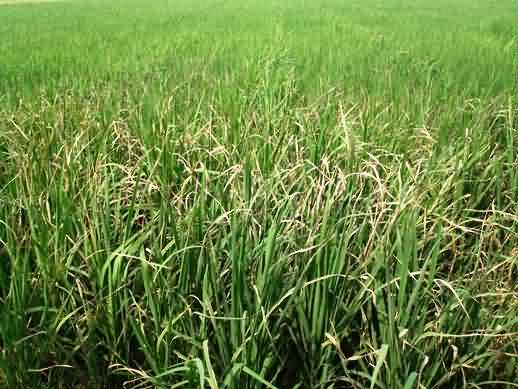
Pathogen: This is a bacterial disease, caused by a bacterium Xanthomonas oryzae pv. oryzicola.
Symptoms: Initially, small, dark-green and water-soaked streaks are seen on interveins from tillering to booting stage. These streaks are dark-green at first and later enlarge to become yellowish gray and translucent. Numerous small yellow beads of bacterial exudates appear on surface of lesions under humid conditions. Brown to greyish white lesions may develop and sometimes yellow halo develop around the lesions. The affected leaves become bleached and greyish white and brown and finally these leaves dry up.
Management:
- The disease can be controlled by proper application of fertilizers, proper planting spacing, and hot water treatment of seeds.
- Field sanitation is important. Ratoons, straws and volunteer seedlings left after harvest can be destroyed to minimize the initial inoculum at the beginning of the season. Providing good drainage system especially in seedbeds can also manage this disease.
- Seed treatment with streptocycline (1g) + carbendazim 50 W.P. (20g) for 8–10 kg of seed in 10 litres of water for 12 – 15 hours.
- Spray the crop 3–4 times with the mixture of copper oxychloride (500 g) and streptocycline (7.5g) in 500 litres of water for one ha at 12–15 days intervals.

Pathogen: This is a fungal disease, caused byPyriculariaoryzae. The perfect stage of the pathogen is Magnaporthegrisea.
Symptoms:
Pathogen causes the disease at seedling and adult stages on the leaves, nodes and panicles. The pinhead-size brown lesions can be confused from the symptoms of brown spot disease. The initial symptoms of this disease develop as white to grey-green lesions or spots with darker borders produced on all parts of shoot. Older lesions are elliptical or spindle-shaped and whitish to gray with necrotic borders. Lesions are wide in the centre and pointed toward either end. Lesions may enlarge and coalesce to kill the entire leaves. Larger lesions (2 cm long) develop at reproductive stage and on younger plants < 1 cm long lesions appear. Symptoms are also observed on leaf collar, culm, culm nodes, and the panicle neck node. Internodal infection of the culm occurs in a banded pattern with a 3-cm blackened necrotic culm and 3-cm healthy tissue in succession. Nodal infection causes the culm to break at the infected node. Few, no seeds or whiteheads are formed when neck is infected or rotten. Panicles also break at the weak point thus causing heavy loss.
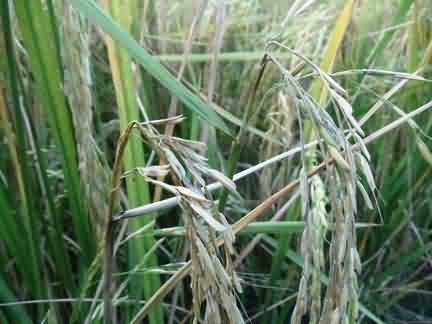
- The manipulation of planting time, early sowing of seeds after the onset of the rainy season is more advisable than late-sown crops to reduce disease incidence.
- Excessive use of fertilizer should be avoided as it increases the incidence of blast. Nitrogen should be applied in small increments.
- Water management practices in rain fed areas lessen the likelihood of stress, which also aid in blast control.
- Seed treatment with thiram @ 2.5g/kg of seed or tricyclazole 75 WP @ 1.5 g/ kg of seed or with carbendazim 50 WP @ 2.0 g/ kg of seed is helpful in reducing the disease.
- On appearance of the disease spray the crop with edifenphos (hinosan 50 EC) or benlate or carbendazim (bavistin) or tricyclazole (beam) @ 0.1%. Four to five sprays at 10–15 days interval may be needed for complete control.
10. Khaira Disease:
This disease is caused due to deficiency of Zinc.
Symptoms:
The disease appears in nursery but may also appear in patches after 10–15 days of transplanting. The leaves of affected plants show chlorosis at the base. Large number of small, brown or bronze spots appears on the lamina surface, which coalesce to form bigger spots and ultimately the entire leaf becomes bronze coloured and dries up. The growth of diseased plant remains stunted. Root growth is also restricted and usually the main roots turn brown. The finer roots are destroyed. In severe conditions, the plants fails to grow further and produce no panicles but sometimes there is natural recovery after 45 days of transplanting.
Management:
- Spray mixture of zinc sulphate (5 kg) and lime (2.5 kg) in 500 litres of waters after 10 days of sowing in the nursery followed by a second spray as above after 25 days of sowing in the nursery.
- Spray can be repeated after 10–15 days of transplanting if symptoms appear in the main field.
- Zinc sulphate (5 kg) and urea (10 kg) in 500 litres of water/ ha can also be sprayed for control of the disease.
Authors:
Ravindra Kumar*, Anuja Gupta, V.K. Maheshwari and S.S. Atwal
Indian Agricultural Research Institute, Regional Station, Karnal – 132001, Haryana
* Corresponding Author:
This email address is being protected from spambots. You need JavaScript enabled to view it. ,
